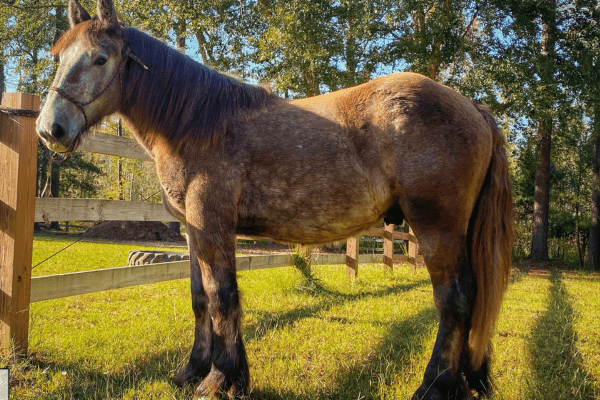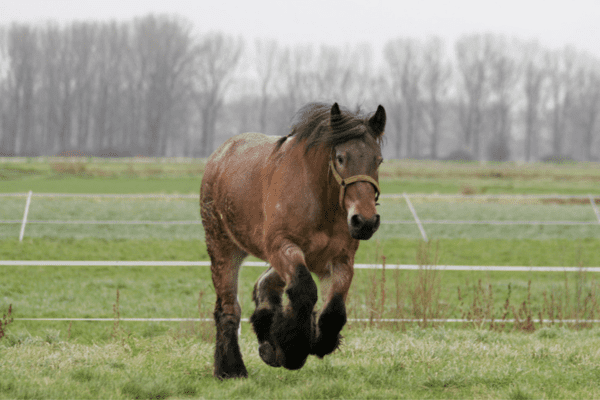The Belgian Draft Horse, famous for its immense strength and gentle temperament, stands as an embodiment of both strength and grandeur.
Originating in modern-day Belgium’s Brabant region, this majestic breed has established itself not only as part of agricultural history but also within hearts worldwide of horse enthusiasts.
Belgian Draught (or ‘Belgisch Trekpaard’ in regional Dutch dialect and ‘Trait belge’ in French) horses embody both power and grace, rising majestically against lush landscapes where they emerged.
Roots intertwine with hearty soil of central Belgian territories; especially that found within once-prominent Province of Brabant – hence another alternative name for them being Brabant Draughts).
Acclaimed as one of the greatest horse breeds worldwide, their history and strength interwoven into cultural and agricultural tapestries throughout Low Countries cultural tapestries that weave stories of strength and endurance throughout.

Common Ancestor:
Shared Ancestry: The American Belgian Draft and the European Belgian Draught share a common ancestor in the venerable Flemish Horse.
European Developments: Over time in Europe, the Flemish Horse blended with Brabant traditions to form what would later become the Belgian Draught beer style.
American Preservation: The American Belgian Draft, popular among Amish communities and in Canada, remains true to its Flemish Horse heritage by maintaining purebred traits of this breed.
Europeans witnessed the Belgian Draught’s transformation into a shorter, sturdy variant with multiple colors available in its coat coats.
Physical Differences: Whilst European Belgian Drafts have maintained their original form, American Belgian Drafts differ both physically and coat color distribution from their European counterparts.
History:
Stepping back into the annals of history, Belgian Draft Horses were initially bred as warhorses in the medieval period, capable of carrying knights and their heavy armor into battle with ease. As the need for warhorses diminished, these sturdy animals found new purpose in farming and hauling heavy loads, contributing significantly to the agricultural and industrial revolutions in Europe and North America.
Belgian Draft Horses can trace their roots all the way back to medieval Europe where they were used as warhorses, capable of carrying knights with heavy armor into battle without incident. Over time however, as warfare reduced, these durable animals found new purpose farming or transporting heavy loads in Europe and North America; making a substantial impactful contribution towards both agricultural and industrial revolutions.


Digging deeper into the heritage and genealogy of the Belgian Draught Horse, we explore its roots across agrarian realms in what is today central Belgium (historically part of the Low Countries). This breed comprises multiple regional horses that each bring unique robustness and charm.
Significant Ancestral Contributions:
Colosse de la Mehaigne: Originating in Namur’s Mehaigne valley, this structure can be found here.
The name Gris de Nivelles et du Hainaut refers to both Hainaut County in Belgium, and Nivelles city located within Walloon Brabant in Wallonia.
Gros de la Dendre: With its origins near the Dender River in East Flanders and contemporary Flemish Brabant.
The Belgian Draught Horse’s legacy extends far beyond its home country; indeed, its first studbook, created in 1886, established breeding standards and ensured lineage purity.
Cross-Continental Presence:
At some point in the late 19th century, American soil saw the first Belgian Draught make its debut – marking an international expansion for this breed.
Even after World War II and with technological innovations like combustion engines emerging, demand for this breed remained stable, reflecting an everlasting appreciation of its distinguishable traits.
As part of an extensive variety of breeds, the Belgian Draught is closely related to other notable European horses; each boasting their own individual story and impactful contribution to equestrian sports.
Genetic Relatives:
The Belgian Draught is genetically related to several other breeds such as Ardennais, Flemish Horse, Nederlands Trekpaard and Trait du Nord horses that further enrich Europe and beyond’s diverse and vibrant equine landscape.
Characteristics:
The Belgian Draught Horse, renowned for its immense strength and gentle temperament, exhibits a plethora of distinct characteristics that have endeared it to horse enthusiasts around the globe. Below are some of the notable attributes of this impressive breed:
Robust Frame: Belgians exhibit a robust build, balanced by proportionally shorter legs.
Size Specifications: Their stature typically falls between 16-17 hands (equivalent to 160-175 cm or 64-68 inches).

Weight Factors: Belgian Shepherds typically range from 1800-2200 pounds (or 800-1100 kg), and come with various coat colors – chestnut, bay, sorrel and black as well as occasionally even roan coats.
Life Expectancy: Pet dogs typically live between 17-22 years, becoming lifelong companions along the way. Durability: In terms of durability, pet dogs typically range between 14 and 18 pounds in weight and require regular brushings or groomings to remain healthy and happy.
These dogs have long been prized for their health and hardiness due to their historical breeding for demanding tasks. Lifespan: On average they live 18 to 25 years; however with proper care some individuals can even outlive this average lifespan.
Common Health Concerns: Horses are vulnerable to chronic progressive lymphedema (CPL) and other issues arising from their large sizes, such as laminitis. Similar issues affect humans as well.
Temperament and Behavior:
Belgian horses have long been revered as “Gentle Giants” due to their calm, docile, and friendly demeanor. Due to their willingness to work, intelligence, and gentle temperament they make suitable candidates for many roles such as farming, logging, show horses and therapeutic riding. Their exceptional tolerance and patience enable them to coexist peacefully with people as well as other animals alike.

The Workhorse of Generations:
Belgian Draft Horses have long played an indispensable role in cultivating land and spurring development around the globe, particularly North America during the 19th and early 20th centuries. Belgians played an essential part in clearing areas for agriculture and urban expansion – their immense pulling power was utilized not only in agricultural fields but also logging camps, coal mines, and hauling freight in urban environments.
Preservation and Legacy:
Modern Belgian Draft Horses hold a special place in heritage farming and historical reenactments, serving as living reminders of bygone days. Their majestic presence at horse shows, parades, and pull competitions ensures their legacy will endure for future generations to admire their strength and beauty. Organizations like the Belgian Draft Horse Corporation of America work diligently to preserve this magnificent breed for future generations to appreciate its strength and beauty.

